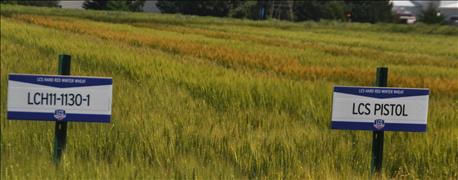
It takes a long time before the first-cross lines in the "nursery" of a winter wheat breeding farm become Y3 lines ready to advance toward release. In a traditional program, that time lapse is traditionally 10 to 12 years. Using modern technology, it can happen is as little as 7 years.
At the Limagrain Cereal Seeds Trio Research Station field day in Valley Center last week, Marla Barnett, the station wheat breeder, told visitors a little bit about each of the hard red winter wheat, hard white winter wheat and triticale varieties that LCS has under development.
LCH11-1130-1
This variety is a re-release of the LCS Pistol line released to foundation increase last year.

"It is the same pedigree, T-158 crossed with a Pioneer line, that has much better stripe rust resistance than Pistol," Barnett said.
She said she considers this variety a potential "T-158 for central and eastern Kansas." T-158 is one of the highest yielding and most popular varieties in western Kansas. It came out of the Trio breeding program and carries the "T" nomenclature for that reason.
Barnett said it is still uncertain whether or not there is a new strain of stripe rust in fields this year, but in Texas T-158, known for its resistance to leaf rust and LCS Pistol, which has good stripe rust resistance, was showing vulnerability. However, the new selection did not have Pistol's weakness in that area.
LCS Elite Experimental Lines
Something to remember: The 13 and 14 lines are all the same family; the 14 class has done well in Nebraska and needs water. The 13 lines are bred for the west and most involve a cross with T-158.
LCH13DH-20-87
This variety has two known genes and possibly a third for stripe rust resistance. It stays green to the ground with all tillers continiuing to grow. In its juvenile stage, the plant takes on the bluish gray color that is often associated with drought resistance.
It is both the Oklahoma State and Kansas State University trials and has shown no winter injury. It is a doubled haploid line with excellent straw strength and very good resistance to leaf rust and stripe rust.
The LC in its nomenclature stands for Limagrain Cereals and the DH for doubled haploid.
LCH13DH-14-91
This variety topped the yield trials in Garden City last year. It has early maturity and is well adapted to the southern growing regions of the Great Plains.
The wheat was the top yielder in the Garden City trials of 2013. It has early maturity, and adaptation for southern growing conditions. Barnett said she hopes to get it unto Texas trails next year.
It has shown yield promise with 136 bushels per acre at Garden City last year.
LC113DH-22-22 and LCI13DH-14-53
Many breeding programs do not have hard red and hard white winter wheat varieties in the same test plots. LCS Trio at Valley Center is doing breeding work on both at the same time.
Two hard white varieites, both from doubled haploid lies, show high yield potential with broad adaptation and good resistance to disease, especially foliar diseases such as leaf and stripe rust.
Work with triticale, too
Limagrain wheat breeder Marla Barnett says she has good reason to appreciate the promise of triticale.
She grew up on a dairy farm in Kentucky and her father loved triticale as a forage and silage feed for his dairy cows.
She said there are at least two lines of Triticale in progress at the Valley Center station that may have promise for Kansas dairy farmers.
Barnett grew up on a dairy farm and said that being able to develop high quality forage for dairy cows has special meaning for her.
About the Author(s)
You May Also Like






